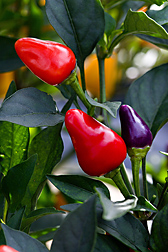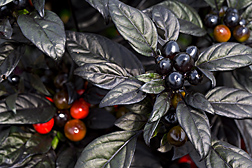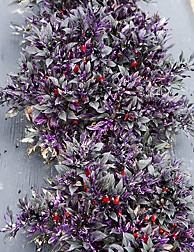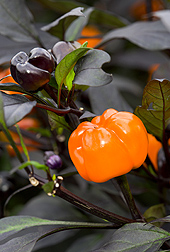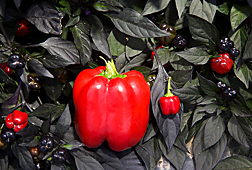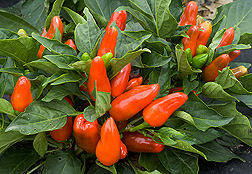Twice as Nice Breeding Versatile Vegetables
|
|
Can you eat your peppers and have them too?
Yes, you can. At least, that’s the opinion of two Agricultural Research Service geneticists. Since 1991, John Stommel, of the ARS Vegetable Laboratory, and Robert Griesbach, of the ARS Floral and Nursery Plants Research Unit, both in Beltsville, Maryland, have bred peppers to please both the eye and the palate. These peppers have been developed through a cooperative research and development agreement with PanAmerican Seed Company and McCorkle Nurseries, Inc.
The eye-catching Black Pearl, released in 2005 and honored as a 2006 All-America Selections (AAS) winner, attests to their success in developing new cultivars with both aesthetic and culinary appeal. The award recognizes new flower and vegetable varieties that demonstrate “superior garden performance” in trials conducted throughout the country.
|
|
Black Pearl is a robust plant, adaptable to environments from New England to California, Stommel says. In addition, it resists attacks from many insects and fungi and is remarkably drought-tolerant.
The pepper is now on display at the U.S. National Arboretum in Washington, D.C., which is part of ARS. With moderately shiny, black leaves and glossy fruits that ripen from black to red, Black Pearl offers a temptation few pepper enthusiasts could resist—and the AAS judges aren’t the only people who think so. Since its release, more than 2 million seeds have been sold.
|
|
A Peck of Pretty Peppers
Black Pearl has company. Stommel and Griesbach look forward to releasing several new pepper cultivars in the future, including one with spreading black foliage and colorful upright peppers with a spicy flavor. Another is exceptionally tall—growing as high as 3 feet. A third, which produces fruit around Halloween, has black foliage and orange, pumpkin-shaped fruit.
Ornamental peppers are just one part of a growing industry. Nursery, landscape, and floral plants are big business, worth about $16 billion a year in this country alone, according to USDA’s Economic Research Service.
|
|
Breeding these culinary ornamental peppers has been a cross-laboratory effort. How did the breeders do it? The first step is to isolate individual traits and select the ones they want, Stommel says. Within the Capsicum genus, there is great variety among qualities—like the size, shape, and color of leaves and fruits.
Griesbach compares the process of pepper breeding to assembling a Mr. Potato Head doll. By selecting specific characteristics, breeders can make desirable combinations. Any new combination will create a novel pepper.
“Only your imagination is limiting,” he says.
Breeding a new cultivar takes 10 to 15 years and involves making crosses and submitting the resulting plants to rigorous tests. But creating tasty and attractive plants isn’t the only benefit of the ornamental pepper breeding program. This work also has applications for many plant genetics studies.
|
|
Pigments Impart More Than Color
These peppers aren’t the first plants to come out of the Vegetable Laboratory with both aesthetic and culinary appeal. Earlier research produced tomatoes rich in the carotenoids lycopene and beta-carotene, red and orange pigments that give tomatoes their characteristic color. Lycopene and beta-carotene are antioxidants and have been linked to health-promoting benefits, so increasing tomatoes’ carotenoid content improves not only their color, but also their nutritional value.
What health benefits do culinary ornamental peppers have? And what can they teach us about other plants? Griesbach and Stommel are now exploring the biochemistry of the anthocyanin pigments responsible for the Black Pearl pepper’s deep-black color.
|
|
In addition to providing pigmentation, anthocyanins in plants have several tasks—including protecting them against strong ultraviolet (UV) sunlight that could damage their cellular DNA. Anthocyanins are located in the outer layers of plants, where increased exposure to UV light or ionizing radiation spurs chemical messenger molecules to speed up anthocyanin production. When consumed, these anthocyanin pigments function as antioxidants.
Griesbach and Stommel have created a system for nutritionists to efficiently evaluate the metabolism of anthocyanins in humans. With a better understanding of that metabolic fate, the scientists envision finding ways to increase the anthocyanin—and nutritional—content of other vegetable crops, not just peppers.
“We must figure out which anthocyanins are the best phytonutrients,” says Griesbach. “Once we know that, we can find and activate the genes involved in their production and move them into other plants.”
|
|
Tomorrow’s Harvest
Initial results have proven positive. In 2005, in controlled-environment experiments inside a growth chamber, Griesbach, Stommel, and colleagues determined environmental conditions for varying anthocyanin production in Black Pearl. Although the plant can adapt to many environments, its growing season and anthocyanin production vary with the temperature and sunlight of its immediate surroundings.
Once the scientific duo gains knowledge of the metabolic pathways at a molecular level—which Griesbach estimates should come sometime in 2006—they’ll know how to increase the nutritional and anthocyanin content of different plant tissues.
“We plan on eventually creating more of these versatile crops,” says Stommel. “These will be plants that, like Black Pearl, not only look good, but can be eaten. These plants will serve as both ornamental and food crops—doubling their value.”
|
|
When more of the anthocyanin research is complete, ARS nutritionists Janet Novotny and Beverly Clevidence, of the Beltsville Human Nutrition Research Center, will be able to evaluate the biological activity of pepper phytonutrients in humans. This work will be useful for future breeding efforts and could allow scientists to produce plants with even higher nutrient content.—By Laura McGinnis and Alfredo Flores, Agricultural Research Service Information Staff.
This research is part of Plant Genetic Resources, Genomics, and Genetic Improvement, an ARS National Program (#301) described on the World Wide Web at www.nps.ars.usda.gov.
John Stommel is with the Vegetable Laboratory, 10300 Baltimore Ave., Beltsville, MD 20705-2350; phone (301) 504-5583, fax (301) 504-5555.
Robert J. Griesbach is in the Floral and Nursery Plants Research Unit, 10300 Baltimore Ave., Beltsville, MD 20705-2350; phone (301) 504-6574, fax (301) 504-5096.
"Twice as Nice Breeding Versatile Vegetables" was published in the September 2006 issue of Agricultural Research magazine.







